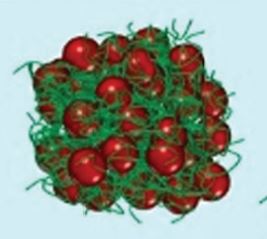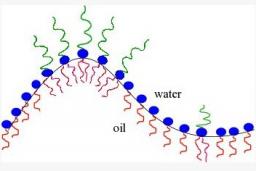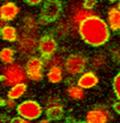Sumit Mehan, Laure Herrmann, Jean-Paul Chapel, Jacques Jestin, Jean-Francois Berret and Fabrice Cousin
We investigate the formation/re-dissociation mechanisms of hybrid complexes made from negatively charged PAA2k coated g-Fe2O3 nanoparticles (NP) and positively charged polycations (PDADMAC) in aqueous solution in the regime of very high ionic strength (I). When the building blocks are mixed at large ionic strength (1 M NH4Cl), the electrostatic interaction is screened and complexation does not occur. If the ionic strength is then lowered down to a targeted ionic strength Itarget, there is a critical threshold Ic = 0.62 M at which complexation occurs, that is independent of the charge ratio Z and the pathway used to reduce salinity (drop-by-drop mixing or fast mixing). If salt is added back up to 1 M, the transition is not reversible and persistent out-of-equilibrium aggregates are formed. The lifetimes of such aggregates depends on Itarget: the closer Itarget to Ic is, the more difficult it is to dissolve the aggregates. Such peculiar behavior is driven by the inner structure of the complexes that are formed after desalting. When Itarget is far below Ic, strong electrostatic interactions induce the formation of dense, compact and frozen aggregates. Such aggregates can only poorly reorganize further on with time, which makes their dissolution upon resalting almost reversible. Conversely, when Itarget is close to Ic more open aggregates are formed due to weaker electrostatic interactions upon desalting. The system can thus rearrange with time to lower its free energy and reach more stable out-of-equilibrium states which are very difficult to dissociate back upon resalting, even at very high ionic strength.
Contact LLB : Fabrice Cousin (LLB/MMB)
"The desalting/salting pathway: a route to form metastable aggregates with tuneable morphologies and lifetimes"
S.Mehan, L. Herrmann, J.-P. Chapel, J. Jestin, J.-F. Berret and F. Cousin, Soft Matter 17 (2021) 8496-8505.
Jyotsana Lal
This article is dedicated to the memory of Loic Auvray
The results on Winsor phases, droplet and bicontinous microemulsions phases with polymer-grafted lipids studied by Small Angle Neutron Scattering (SANS) are reported below, together with the contrast variation techniques used to characterize the average curvature in the system. We have clearly shown that polymer-grafted lipids change the interaction between microemulsion droplets --it need not be just repulsive but could also be attractive. They induce structural changes or bring about complete phase changes as observed visually in the Winsor phases when added in sufficient amounts. In the bicontinous microemulsion phases, the polymer-grafted lipids decrease the persistence length, hence the bending rigidity, increase the apparent average thickness of the film, and cause a complex deformation of the film which brings about a negative curvature change at a semi-local scale. Contrary to the naive prediction that the polymer-grafted lipids should increase membrane rigidity our experiments show a decrease. This is a subtle effect caused by perhaps an indirect coupling between film curvature and concentration fluctuations.
Imogolites (OH)3Al2O3Si(OH) are natural minerals discovered in 1962 in Japanese volcanic soils. Their structure is similar to that of a carbon nanotube. They are made of a curved Gibbsite sheet Al(OH)3 forming a nanotube of 2 nm in diameter. The tetrahedral silicon adsorbed inside the nanotube controls its curvature. The diificulties to synthesized large quantities of this mineral have indered the development of industrial applications. Recently a new synthetic process has allowed to circumvent this difficulty. Research are now performed to better understand and control this new synthesis.
Scientists at the "Laboratoire de chimie et biologie des métaux" (CEA-CNRS-Université J. Fourier, CEA-Grenoble), "Laboratoire de chimie des surfaces et interfaces" (CEA-Saclay) and a team at the Laboratoire d'innovation pour les technologies des énergies nouvelles et les nanomatériaux" (CEA Grenoble) have combined nanoscience and bio-inspired chemistry to develop, for the 1st time, a paltinum free material capable of catalyzing both production of hydrogen and its use in a fuel cell.
This result, important in view of a more competitive hydrogen economy is being published in the journal Science.
Amphiphilic molecules have a hydrophilic head and a hydrophobic chain. Under certain conditions, they can self-organize into hollow spherical hollow vesicles with a surfactant bilayer enclosing an aqueous core, the overall diameter ranging from a few tens of nanometers to several microns. By carefully choosing specific preparation conditions, the scientists of SIS2M have shown that extremely robust aggregates can be synthesized with an interesting potential for encapsulation.
The vesicles are widely studied for many fundamental issues (mechanism of self-assembly, physical properties of the membrane, etc ...) which understanding may open new perspectives (controlled release of active molecules, chemical nanoreactors, energy conversion, etc...). Usually, these vesicles (in this case also known as "liposomes") are prepared from phospholipids, that also form cell membranes. It would be advantageous to replace the phospholipids with molecules with similar properties but with more accessible or easily modified chemical functions, such as fatty acids molecules. It was already possible to synthesize such vesicles of fatty acids in specific conditions of temperature and pH, but the way to stabilize them was yet to be found: they are indeed very sensitive to external conditions and are destroyed easily to give micelles or crystals.









 Synthèse et caractérisation des nano-objets / Synthesis and characterization of nano-objects
Synthèse et caractérisation des nano-objets / Synthesis and characterization of nano-objects




